 |
Hawksbill Turtles
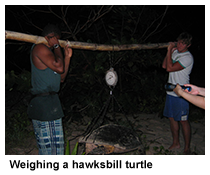 The Barbados Sea Turtle Project monitors the sandy, leeward coast beaches of the island nightly during the hawksbill nesting season (June 1st to October 31st). Three separate monitoring groups, each covering different beaches on the west and south coasts set out at 8:00 pm in order to document all hawksbill turtle nesting activity. Our volunteers not only look for nesting females when they come out of the sea to nest, but also for any signs such as tracks that indicate that a female has been on the beach. The Barbados Sea Turtle Project monitors the sandy, leeward coast beaches of the island nightly during the hawksbill nesting season (June 1st to October 31st). Three separate monitoring groups, each covering different beaches on the west and south coasts set out at 8:00 pm in order to document all hawksbill turtle nesting activity. Our volunteers not only look for nesting females when they come out of the sea to nest, but also for any signs such as tracks that indicate that a female has been on the beach.
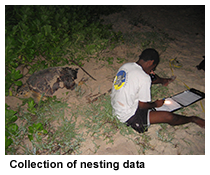 If an activity is found and the female has already left the beach, our volunteers document the type of activity that has taken place. Data collection focuses on the following questions: Did the female attempt to nest, but was unsuccessful? Was she disturbed during her time on land? Was she able to nest? Are the eggs safe at their current location? These questions can usually be answered by looking at the tracks left behind and the patterns of disturbed sand as well as the local environment. If an activity is found and the female has already left the beach, our volunteers document the type of activity that has taken place. Data collection focuses on the following questions: Did the female attempt to nest, but was unsuccessful? Was she disturbed during her time on land? Was she able to nest? Are the eggs safe at their current location? These questions can usually be answered by looking at the tracks left behind and the patterns of disturbed sand as well as the local environment.
If the turtle is still present when our volunteers arrive, they read her tag numbers or give her new tags if necessary. Measurements of her carapace (shell) are taken, along with beach measurements and site observations in relation to the nest location. Long term nesting beach tagging programmes provide unique information about the distribution and abundance of female turtles as well as estimates of inter-nesting intervals (the time between successive nests) and remigration intervals (the number of years between nesting seasons for a given turtle).
Leatherback Turtles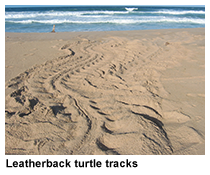
Barbados Sea Turtle Project volunteers monitor the beaches of the east (windward) coast of the island once per week during the leatherback nesting season (March 1st to July 31st). Monitoring commences at 6:00 am. Nesting leatherback turtles are occasionally seen and tagged by this monitoring group.
Nest Protection and Relocation
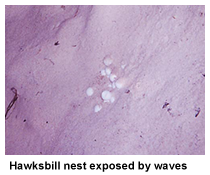 It is important that the site where a sea turtle has nested will be safe for the duration of the incubation period (approximately 60-days). Since moving a sea turtle nest reduces its chance of success, eggs should not be moved unless they are likely to be destroyed at their original location. If the eggs are not safe due to washout by high wave activity, predation by dogs or mongooses, or if they are in an area of high foot or vehicular traffic, our volunteers will carefully relocate them to a safer area. It is important that the site where a sea turtle has nested will be safe for the duration of the incubation period (approximately 60-days). Since moving a sea turtle nest reduces its chance of success, eggs should not be moved unless they are likely to be destroyed at their original location. If the eggs are not safe due to washout by high wave activity, predation by dogs or mongooses, or if they are in an area of high foot or vehicular traffic, our volunteers will carefully relocate them to a safer area.
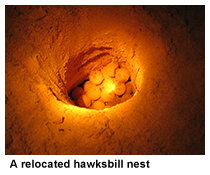 We ensure that each relocated nest remains as close to its original site as possible. Because of this, we will not move a nest from a south coast location (for example, the Turtle Beach Resort) to a west coast location (for example, the Sandy Lane Hotel). Eggs are relocated to a nearby beach on the same coast from which they were taken. We ensure that each relocated nest remains as close to its original site as possible. Because of this, we will not move a nest from a south coast location (for example, the Turtle Beach Resort) to a west coast location (for example, the Sandy Lane Hotel). Eggs are relocated to a nearby beach on the same coast from which they were taken.
Nest Excavation
Most hatchling turtles emerge during the night or early morning. After the hatchlings have emerged from a nest, our volunteers excavate that nest. The nest contents are examined and counted in order to determine hatching success.
By attempting to document all nesting activity around the island, the Barbados Sea Turtle Project is able to monitor the populations of hawksbill and leatherback turtles (and rarely green turtles) that use Barbados as their nesting habitat. |
|
| |
 |
Hawksbill Turtles
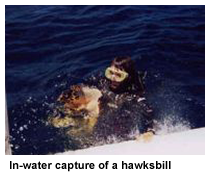 Two to three days per week during the nesting season, the Barbados Sea Turtle Project goes SCUBA diving with the assistance of High Tide Watersports in order to catch juvenile hawksbill sea turtles that reside on reefs along the west coast of Barbados. Upon capture, turtles are brought up to the dive boat where data is collected. The turtles are tagged, measured, weighed and photographed. Each turtle has a unique identification number etched into its shell before it is released. Two to three days per week during the nesting season, the Barbados Sea Turtle Project goes SCUBA diving with the assistance of High Tide Watersports in order to catch juvenile hawksbill sea turtles that reside on reefs along the west coast of Barbados. Upon capture, turtles are brought up to the dive boat where data is collected. The turtles are tagged, measured, weighed and photographed. Each turtle has a unique identification number etched into its shell before it is released.
Green Turtles
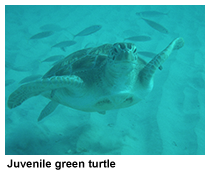 Green turtles are found feeding on seagrass and algae around the island. Many persons travel to Barbados to swim with the juvenile green turtles on our west coast. Every six months, the Barbados Sea Turtle Project, in collaboration with the Coastal Zone Management Unit, Ocean Adventures Cruises and Barbados Blue Watersports, visits the popular "swim with the turtle" sites to capture and examine the juvenile green turtles. As with the hawksbills, turtles are tagged, measured, weighed and photographed before being released. Green turtles are found feeding on seagrass and algae around the island. Many persons travel to Barbados to swim with the juvenile green turtles on our west coast. Every six months, the Barbados Sea Turtle Project, in collaboration with the Coastal Zone Management Unit, Ocean Adventures Cruises and Barbados Blue Watersports, visits the popular "swim with the turtle" sites to capture and examine the juvenile green turtles. As with the hawksbills, turtles are tagged, measured, weighed and photographed before being released.
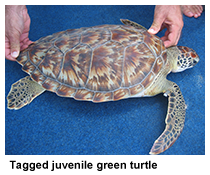 We have found that these turtles, that are usually fed fish by the boats bringing visitors to the sites, grow faster and weigh more than turtles of the same size that feed naturally on plants. The Barbados Sea Turtle Project is currently cooperating with a veterinary research group in order to determine whether this is a potential health concern. We have found that these turtles, that are usually fed fish by the boats bringing visitors to the sites, grow faster and weigh more than turtles of the same size that feed naturally on plants. The Barbados Sea Turtle Project is currently cooperating with a veterinary research group in order to determine whether this is a potential health concern.
Over 1,300 hawksbill and green turtles have been tagged and identified by the Barbados Sea Turtle Project since mid 1998 when the in-water tagging programme began. If a turtle is re-sighted at an interval of six or more months, it is recaptured for measurement and weighing as part of our ongoing study. Subsequent recaptures and sightings provide information on growth rates, the movements of turtles between reefs and the locations of the most important foraging habitats (reef systems and seagrass beds) off the Barbados coastline. |
|
| |
 |
Adult Turtles
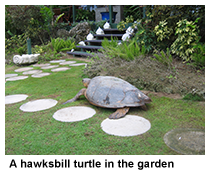 Nesting female sea turtles are occasionally disoriented by lights as they make their way back to the sea. If this happens, they may wander onto hotel grounds and into swimming pools, construction sites or drains close to the beach. If a narrow beach is close to a main road, female sea turtles may cross the road in pursuit of suitable nesting habitat. Nesting female sea turtles are occasionally disoriented by lights as they make their way back to the sea. If this happens, they may wander onto hotel grounds and into swimming pools, construction sites or drains close to the beach. If a narrow beach is close to a main road, female sea turtles may cross the road in pursuit of suitable nesting habitat.
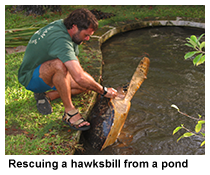 An adult turtle that has wandered inland may become trapped behind a sea wall, or may be injured if she falls into a drained swimming pool or is hit by a car. Volunteers from the Barbados Sea Turtle Project rescue trapped or disoriented nesting female turtles and guide them back to the sea. If a turtle is injured, we ensure that she receives necessary treatment with the assistance of Dr. Gus Reader, a local veterinarian. An adult turtle that has wandered inland may become trapped behind a sea wall, or may be injured if she falls into a drained swimming pool or is hit by a car. Volunteers from the Barbados Sea Turtle Project rescue trapped or disoriented nesting female turtles and guide them back to the sea. If a turtle is injured, we ensure that she receives necessary treatment with the assistance of Dr. Gus Reader, a local veterinarian.
Hatchling Turtles
Hatchling sea turtles are strongly attracted to lights. This is because they instinctively seek out the brightest horizon, which under natural conditions would be the sea. However, these turtles often crawl landward toward the lights at hotels and condominiums, and may even cross main roads while crawling toward street lights.
 If the volunteers from the Barbados Sea Turtle Project find disoriented sea turtle hatchlings, we collect them and release them at a dark beach on the same day or night when they were collected. If the volunteers from the Barbados Sea Turtle Project find disoriented sea turtle hatchlings, we collect them and release them at a dark beach on the same day or night when they were collected.
Our volunteers make every attempt to release hatchlings as close to the beach where they were collected as possible. If hotel lights that shine onto the beach can be turned off, they can often be released at the same beach. However, this may not always be possible and ongoing coastal development in Barbados is making suitably dark beaches increasingly difficult to find.
Juvenile and Foraging Turtles
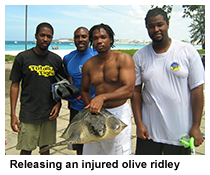 Many species of sea turtles migrate through Barbados’ waters and forage around the island throughout the year. Occasionally, these turtles find themselves in dangerous situations. Many species of sea turtles migrate through Barbados’ waters and forage around the island throughout the year. Occasionally, these turtles find themselves in dangerous situations.
Entanglement in abandoned fishing gear can result in reduction of mobility, limb amputation or drowning, while swallowing fishing hooks or garbage such as deflated balloons, plastic bags and bottle caps can block the digestive tract, making feeding extremely difficult. Boat strikes can result in serious injuries as both the hull and propeller of a boat can damage the shell, lungs and spine of a sea turtle.
Debilitated turtles are often weak and unable to swim against strong currents and may become stranded in shallow water. The Barbados Sea Turtle Project works to rehabilitate stranded sea turtles with the assistance of Dr. Gus Reader. At the Central Veterinary Clinic, turtles can be X-rayed and have foreign objects surgically removed. In most cases, rehabilitated turtles are able to make a full recovery and can be released close to shore or at sea if necessary. |
|
| |
 |
| As part of our conservation activities, the Barbados Sea Turtle Project collects tissue samples from both nesting adult and foraging juvenile sea turtles. DNA extracted from these samples can be used to investigate the population structure of the nesting and foraging turtles of Barbados.
Hawksbill Turtles
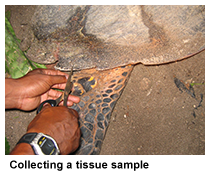 Genetic analyses have shown that the nesting populations of Caribbean hawksbill turtles are genetically distinct (Bass et al., 1996), while the foraging grounds are occupied by individuals from numerous nesting populations (Bowen et al., 1996; Bowen et al., 2007). Because of this, the genetic composition of nesting populations can be used to estimate their contribution to regional foraging aggregations. Genetic analyses have shown that the nesting populations of Caribbean hawksbill turtles are genetically distinct (Bass et al., 1996), while the foraging grounds are occupied by individuals from numerous nesting populations (Bowen et al., 1996; Bowen et al., 2007). Because of this, the genetic composition of nesting populations can be used to estimate their contribution to regional foraging aggregations.
A recent study in Barbados (Browne et al., 2009) has revealed a high level of structuring within the island's hawksbill nesting population. The population of the leeward (west) coast is genetically distinct from that on the windward (east) coast. As a result, the turtles nesting on each coast can be considered as separate populations. This study also revealed that the Barbados nesting population, the second largest in the Wider Caribbean, contributes more to regional foraging aggregations, ie. the animals seen around other islands, than was previously estimated.
Green Turtles
Analysis of genetic material from the local green turtle population has revealed that the green turtles seen foraging around Barbados are from Ascension Island, Aves (Bird) Island, Surinam, Costa Rica, Florida and Mexico.
These results emphasise the importance of cooperation between Barbados and the different sea turtle range states in order to ensure the success of domestic conservation measures, as turtles protected under Barbadian law may migrate to waters where they can be legally harvested, while turtles from other countries use Barbados as their feeding ground. |
|
| |
 |
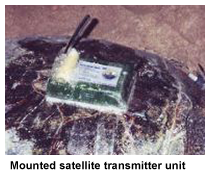 Adult female hawksbill turtles (Eretmochelys imbricata) have been fitted with satellite transmitters in order to investigate post-nesting movements from the beaches of Barbados to their foraging grounds elsewhere in the Caribbean and their movements along Barbados’s coasts during inter-nesting intervals (i.e. the time periods between nesting emergences within a season). This work began in the 1998 as part of a Caribbean-wide hawksbill research satellite tracking project. Adult female hawksbill turtles (Eretmochelys imbricata) have been fitted with satellite transmitters in order to investigate post-nesting movements from the beaches of Barbados to their foraging grounds elsewhere in the Caribbean and their movements along Barbados’s coasts during inter-nesting intervals (i.e. the time periods between nesting emergences within a season). This work began in the 1998 as part of a Caribbean-wide hawksbill research satellite tracking project.
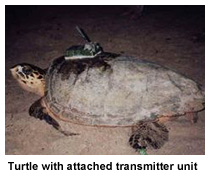 Since then, six animals have been followed from Barbados to their foraging grounds, with females travelling for periods of between 7 and 18 days to reach foraging grounds in Dominica, Grenada, Trinidad, Venezuela, Dominican Republic and Guadeloupe. Straight-line travel distances ranged from 200 to more than 1000 km. One animal has been tracked in two different nesting seasons and she returned on each occasion to the same foraging ground, suggesting that hawksbills are not only faithful to their nesting beaches, but also their foraging grounds. Since then, six animals have been followed from Barbados to their foraging grounds, with females travelling for periods of between 7 and 18 days to reach foraging grounds in Dominica, Grenada, Trinidad, Venezuela, Dominican Republic and Guadeloupe. Straight-line travel distances ranged from 200 to more than 1000 km. One animal has been tracked in two different nesting seasons and she returned on each occasion to the same foraging ground, suggesting that hawksbills are not only faithful to their nesting beaches, but also their foraging grounds.
These data do indicate however that some adult females nesting in Barbados, where they are fully protected, may spend the majority of their lives in waters where they are only partially protected or unprotected.
Work on movements of females that nest at Needham’s Point (the national index beach) is on-going. The objective of this project is to discover the nearshore marine areas where females rest between nesting emergences, with a view to establishing marine boundaries for a restricted area for sea turtles nesting on this regionally significant nesting beach.
The satellite tracking studies are being funded by the Marine Turtle Conservation Fund, the Barbados Tourism Development Corporation, and UWI. |
|
| |
 |
|

